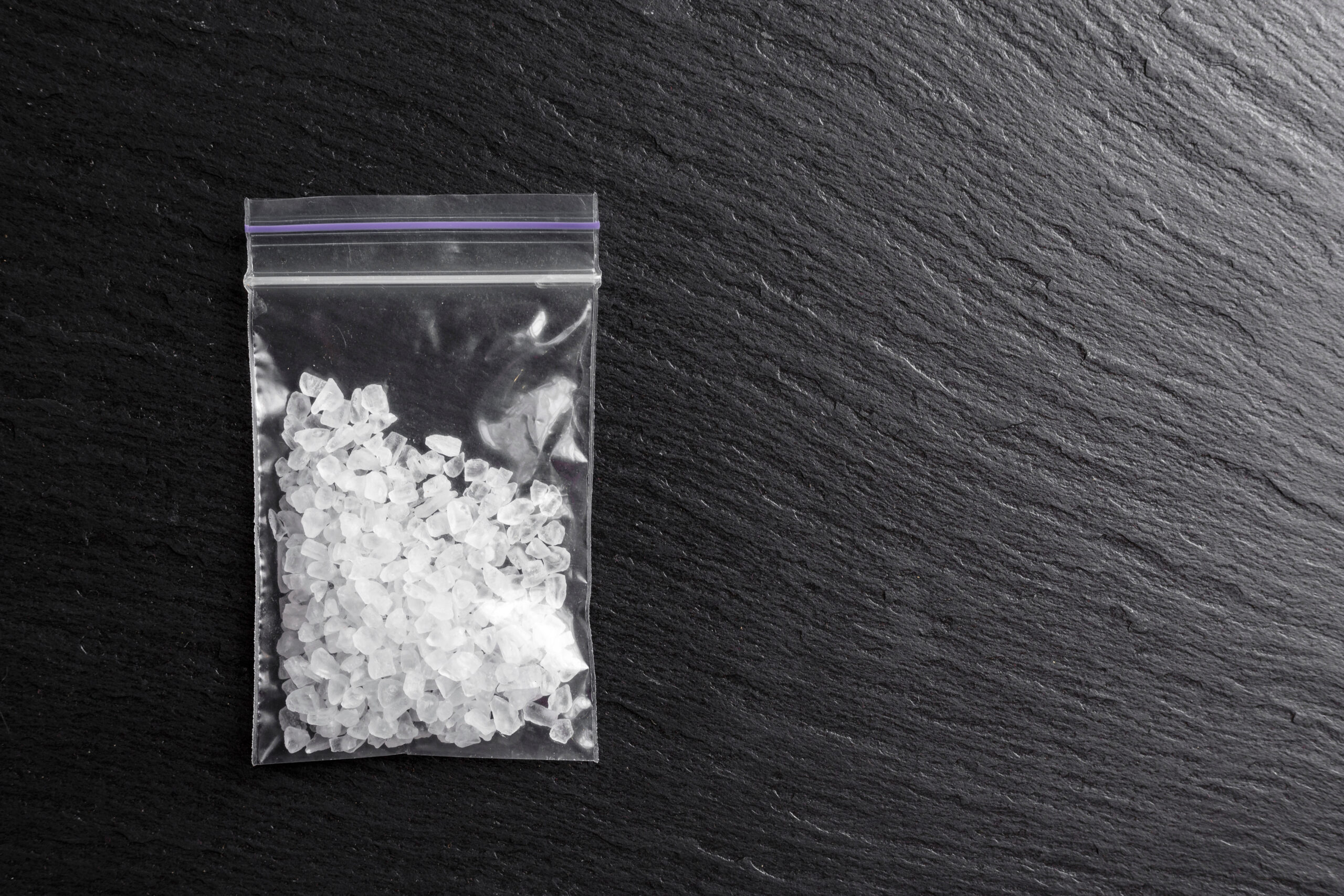Substances | 4 min read
What is the Drug Crank?
Medically Reviewed By

On March 13, 2023
Written By
On March 13, 2023

Drug abuse, addiction, and overdose are rising problems worldwide as people experiment with various substances to escape or enhance their reality. One substance that has caused a stir in recent years is the drug “crank,” also known as crystal meth or methamphetamine. This powerful stimulant drug has been linked to severe health risks and has intense addictive properties that users should be aware of.
What is Crank?
“Crank” is a slang term that refers to a highly addictive stimulant drug called methamphetamine[1]. This drug affects the central nervous system and can cause various physical and psychological effects. Crank is typically consumed in its crystallized form, known as crystal meth, by smoking, snorting, or injection.
How is Crank Made?
Crank is a dangerous drug made from a combination of household chemicals and pseudoephedrine, a common cold and allergy medicine ingredient. Drug manufacturers extract pseudoephedrine from pills or tablets and mix it with other chemicals like lithium or drain cleaner. These added chemicals increase the drug’s potency and toxicity, making it extremely hazardous to consume.
After refining, the mixture goes through a chemical called “red phosphorus synthesis.” It involves mixing substances such as red phosphorus and iodine with water. The chemical reaction is what creates the methamphetamine.
Crank is frequently manufactured in secret, often by small-scale producers working in makeshift labs in various locations ranging from homes and garages to manufacturing plants and boats.
Due to their unlicensed and unregulated status, these producers lack oversight and quality control measures that make it challenging to ensure the consistency and safety of the production process. This variable and unreliable production process often leads to hazardous concentrations.
How Does Crank Affect Users?
Crank can have several severe physical and psychological effects on the body, most of which can be incredibly dangerous for users regardless of how long the drug is consumed.
Crank increases dopamine levels in the brain, enhancing mood, energy, and alertness. It also causes an increase in heart rate, blood pressure, and body temperature. The physical effects of crank use can cause dehydration, sweating, and weight loss.
When taken in high doses, overdose symptoms are similar to those of other stimulants such as cocaine and amphetamines. Some of the symptoms of overdose include convulsions, hallucinations, and confusion.
Crank use can change the brain’s chemistry, leading to intense psychological effects[2], such as mood swings, anxiety, and paranoia. It can cause delusions and hallucinations, leading users to become aggressive and sometimes exhibit violent behavior. It can also lead to insomnia, depression, and suicidal thoughts.
What are the Symptoms of Crank Addiction?
Crank addiction is a serious and potentially life-threatening condition. It is essential to be aware of the symptoms of crank addiction to seek treatment as soon as possible.
One of the most common signs of crank addiction is a sudden and significant increase in energy levels. Users may experience a surge of energy that can last for hours or even days, leading to insomnia and fatigue. They may also seem restless and unable to relax.
Another symptom of crank addiction is a change in appetite. Methamphetamine suppresses appetite, so users may lose weight quickly and appear emaciated. They may also become dehydrated, leading to dry mouth and bad breath.
In addition to physical symptoms, there are also behavioral signs of crank addiction. Those using the drug may experience mood swings, including feelings of euphoria and irritability. They may become paranoid, experiencing delusions or hallucinations. They may also engage in risky behaviors, such as driving under the influence.
Over time, the effects of crank addiction can become more severe. Those addicted to crank may experience health problems like heart disease, seizures, and kidney failure. They may also suffer from mental health issues like depression and anxiety.
Crank Addiction Treatment Options
Addiction to crystal methamphetamine can be a challenging and overwhelming experience. Crank addiction can take hold of a person’s life, leading to severe consequences for their physical, emotional, and mental health. However, with proper support and treatment, overcoming this addiction and reclaiming your life is possible.
There are several treatment options available for people struggling with crank addiction. These treatment options can vary depending on a person’s needs, addiction severity, and personal preferences. Here are some common crank addiction treatment options:
Inpatient Rehabilitation
Overcoming crank addiction can be challenging, but inpatient rehabilitation programs provide a safe, structured environment to help individuals succeed. These programs typically last from 30 days to 6 months, when people receive personalized therapy and medical care. With the added support of group therapy and social connections, recovering from addiction becomes a real possibility.
Outpatient Treatment
Outpatient treatment programs offer more flexibility than inpatient rehab. Outpatient treatment programs allow you to live at home, go to work or school, and still receive the help you need. You’ll attend individual and group therapy sessions at a treatment facility for a few hours per week.
Counseling and Therapy
Overcoming crank addiction is possible with counseling and therapy. Through professional guidance, individuals can tackle the causes of their addiction and learn effective strategies to cope with their triggers. Evidence-supported treatments like cognitive-behavioral therapy (CBT), contingency management, and motivational enhancement therapy (MET) are effective in treating crank addiction.
Medication-Assisted Treatment (MAT)
Effective treatment for crank addiction involves medication-assisted therapy (MAT). Medications like buprenorphine, methadone, and naltrexone can alleviate withdrawal symptoms and curb cravings. Combined with expert counseling and therapy, this approach can maximize addiction treatment success.
How to Get Help for a Crank Addiction
If you are struggling with a crank addiction and find that you can’t stop, Ascendant can help. The caring team at our Drug Rehab in NYC is standing by to help you start your recovery journey. It is never too late to start recovery, give us a call, our admissions team is standing by to help.
Frequently Asked Questions About Crank
Crank is a powerful stimulant that produces intense euphoria and increased energy. Unfortunately, it also causes adverse side effects such as rapid heartbeat, reduced appetite, sleep disturbances, paranoia, and violent behavior. Users often report feeling very alert and focused, but these effects are short-lived and can quickly lead to addiction and physical dependence.
Yes, crank is highly addictive, and prolonged use can lead to physical and psychological dependence. Withdrawal from crank can also cause unpleasant symptoms, including depression, anxiety, fatigue, and intense cravings. The addiction cycle is often challenging to break, and most users require professional help to overcome their addiction.
Methamphetamine hydrochloride is sometimes prescribed in severe cases of ADHD, narcolepsy, and obesity. Although this drug is prescribed, it comes with risks and is not used as a first line treatment.
Crank is considered dangerous for several reasons. As a potent stimulant, it harms the body and brain, ranging from cardiovascular disease and respiratory problems to irreversible brain damage. Prolonged drug use can lead to malnutrition, dehydration, and dental issues. Those who use crank often suffer from legal problems, social isolation, and financial difficulties. Overall, crank is a dangerous drug that should not be used under any circumstances.
Get Help for a Crank Addiction
Crank addiction doesn’t have to define you. There is a better way to live. Contact a member of our team today to learn about our life-changing addiction treatment programs.
Ascendant New York Editorial Guidelines
Here at Ascendant New York, we understand the importance of having access to accurate medical information you can trust, especially when you or a loved one is suffering from addiction. Find out more on our policy.
[1] Yasaei, R., & Saadabadi, A. (n.d.). Methamphetamine. National Library of Medicine. Retrieved from https://www.ncbi.nlm.nih.gov/books/NBK535356/ on April 27, 2023
[2] Sheridan, J., Bennett, S., Coggan, C., Wheeler, A., & McMillan, K. (2006, March 29). Injury associated with methamphetamine use: A review of the literature – harm reduction journal. BioMed Central. Retrieved from https://harmreductionjournal.biomedcentral.com/articles/10.1186/1477-7517-3-14 on April 27, 2023,
[3] Cruickshank, C. C. (2009, June 4). A review of the clinical pharmacology of methamphetamine. Wiley Online Library. Retrieved from https://onlinelibrary.wiley.com/doi/full/10.1111/j.1360-0443.2009.02880.x on April 27, 2023




